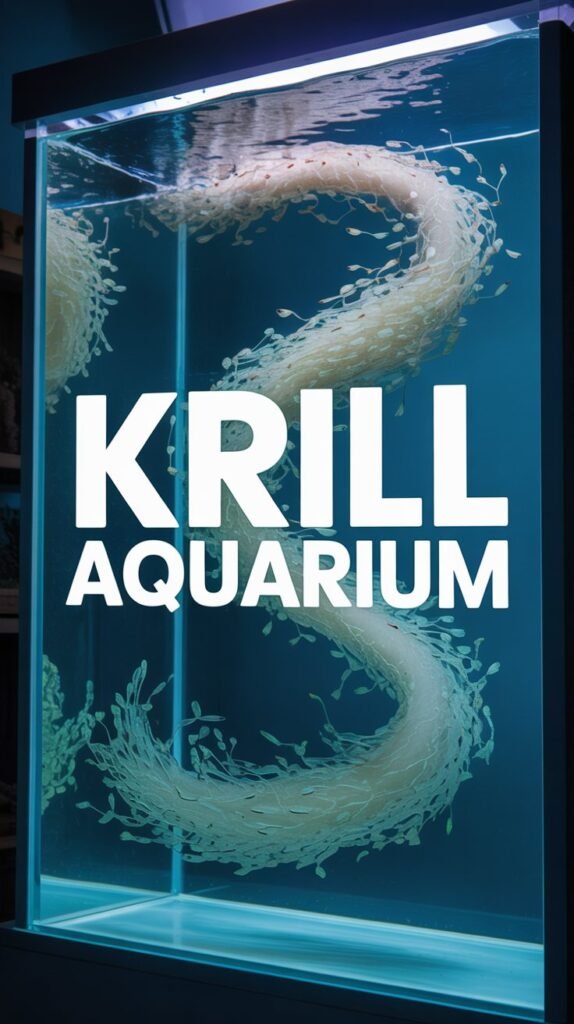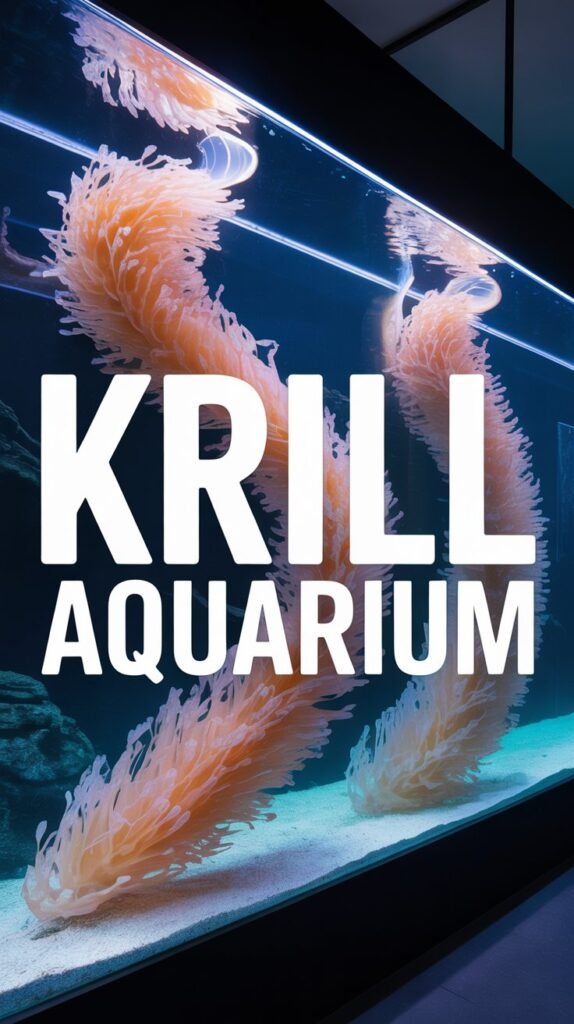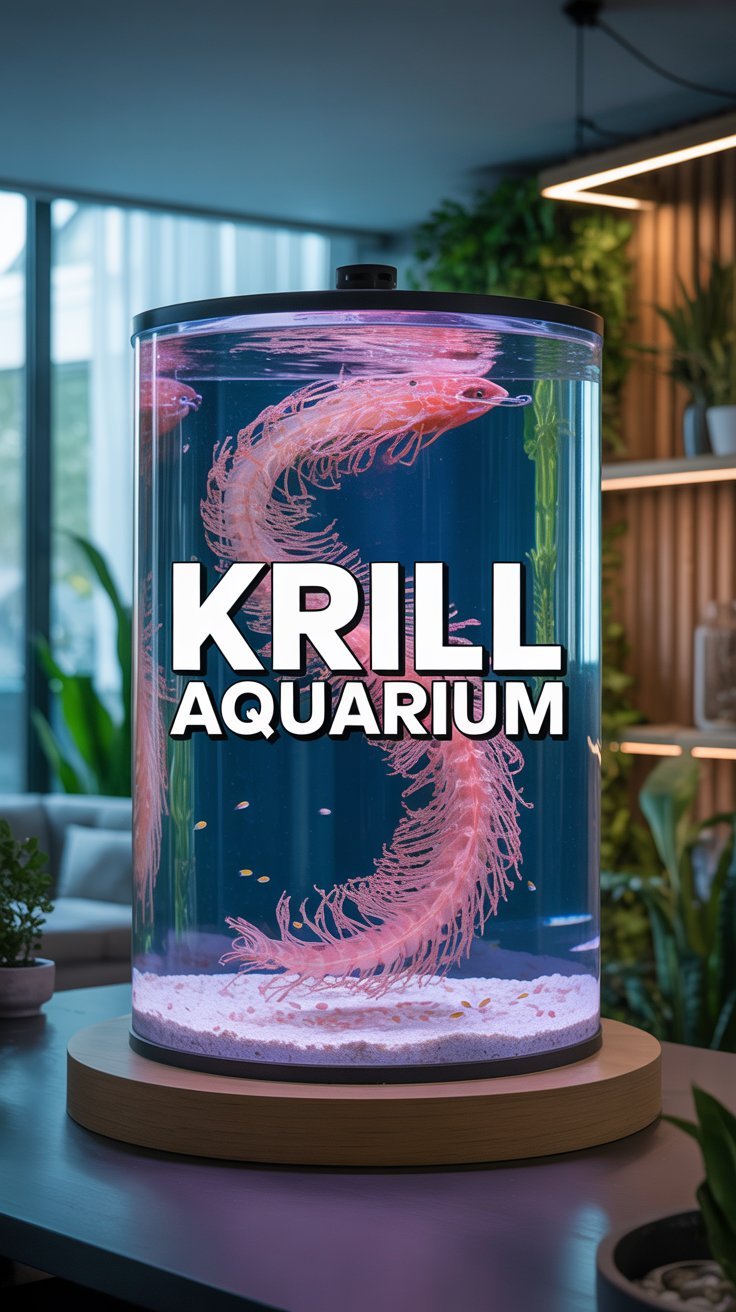When it comes to creating a balanced and nutrient-rich aquarium ecosystem, few creatures play as valuable a role as krill. These small, shrimp-like crustaceans are not only fascinating to observe but also serve as a critical food source for many fish and marine animals. Setting up a krill aquarium can be an exciting and rewarding experience for both beginners and seasoned aquarists.
In this comprehensive guide, we’ll explore everything you need to know about krill—from their biology and habitat needs to feeding practices, breeding techniques, and their role in aquarium nutrition. By the end, you’ll have a deep understanding of how to maintain a thriving krill aquarium and how krill can benefit your aquatic environment.
What Are Krill?
Krill are small marine crustaceans belonging to the order Euphausiacea. There are over 80 known species of krill distributed throughout the world’s oceans, but the most well-known species is the Antarctic krill (Euphausia superba). These tiny animals form a critical part of the ocean’s food web, serving as a primary food source for whales, seals, penguins, and many fish species.
In aquariums, krill are often used as a nutrient-rich food source due to their high protein, omega-3 fatty acid, and carotenoid content. However, some aquarists also enjoy keeping live krill in specialized marine systems, both for observation and to maintain a natural ecosystem.
Why Keep Krill in Aquariums?

There are several reasons to maintain a krill aquarium, depending on your goals as an aquarist:
1. Natural Food Source
Krill are an excellent live or frozen food for a wide range of marine and freshwater species, including:
- Tangs and Angelfish
- Clownfish
- Discus and Cichlids
- Seahorses
- Coral species
Their nutritional value promotes growth, coloration, and reproductive health in aquarium fish.
2. Nutrient Recycling
Krill can help break down organic waste, contributing to nutrient cycling in reef and marine setups. They consume phytoplankton, bacteria, and detritus, helping maintain clean and balanced water conditions.
3. Educational and Research Use
A krill aquarium offers valuable learning opportunities about marine food webs, ecological balance, and crustacean behavior—making them ideal for classrooms and marine biology enthusiasts.
4. Aesthetic and Natural Appeal
A tank full of active krill creates dynamic movement and enhances the natural beauty of marine aquariums, especially when combined with corals and small fish species.
Understanding Krill Habitat and Behavior
1. Natural Habitat
Krill inhabit both coastal and open ocean waters. They thrive in cold, oxygen-rich environments and form dense swarms that can stretch for kilometers. In nature, they migrate vertically—rising toward the surface at night to feed and descending to deeper waters during the day to avoid predators.
2. Behavior in Captivity
In aquariums, krill are active swimmers that prefer moderate water flow and dim lighting. They often gather near the substrate or in midwater levels. Keeping them in groups is essential because krill are social and display natural schooling behavior.
Setting Up a Krill Aquarium
Creating the right environment for krill is essential for their survival and reproduction. Here’s how to set up a healthy krill aquarium system.
1. Tank Size
A krill tank should be at least 20 gallons for small-scale culture and up to 50 gallons or more for stable long-term colonies. The larger the tank, the more stable the water parameters and the healthier your krill population will be.
2. Water Conditions
Krill require stable marine conditions with the following parameters:
| Parameter | Ideal Range |
|---|---|
| Temperature | 5°C – 15°C (Antarctic species) or 18°C – 22°C (tropical krill) |
| Salinity | 1.024 – 1.026 specific gravity |
| pH | 7.8 – 8.2 |
| Ammonia/Nitrite | 0 ppm |
| Nitrate | Below 20 ppm |
| Oxygen | High (use air stones or wavemakers) |
3. Filtration and Aeration
Krill are sensitive to ammonia and nitrite, so a biological filtration system is essential. Use sponge filters or gentle flow systems to avoid sucking krill into filter intakes. Aeration is also critical since krill require high oxygen levels.
4. Lighting
Provide low to moderate lighting. Krill do not need strong illumination and may become stressed under bright lights. Using a dim blue light can help replicate their natural environment.
5. Substrate and Decor
A bare-bottom tank is easiest to clean, but you can also use fine sand to create a more natural habitat. Avoid sharp decorations that could injure the delicate krill.
6. Water Movement
Gentle water flow is ideal. Excessive current can exhaust or damage krill, while stagnant water leads to oxygen depletion.
Feeding Krill in Aquariums
1. What Do Krill Eat?
Krill are primarily filter-feeders, consuming:
- Phytoplankton
- Microalgae
- Bacteria
- Small detritus particles
In captivity, you can feed them a mix of live or prepared foods such as:
- Spirulina powder
- Marine phytoplankton cultures
- Microalgae pastes
- Crushed fish flakes or pellets
- Yeast suspensions
2. Feeding Frequency
Feed small amounts twice daily. Overfeeding can cause ammonia spikes and poor water quality, so only add as much food as they can consume within 10–15 minutes.
3. Supplements
Adding small doses of marine trace elements and vitamins improves growth and reproduction rates. Krill benefit from sources of omega-3 fatty acids and carotenoids for pigmentation.
Breeding Krill in Aquariums

Breeding krill can be challenging, but with proper conditions and patience, it’s possible. Here’s what you need to know:
1. Sexual Dimorphism
Male and female krill can be distinguished by:
- Males: Slimmer bodies and modified pleopods (swimming legs).
- Females: Rounder abdomens with brood sacs for carrying eggs.
2. Mating and Spawning
Under stable conditions, males transfer sperm to females during mating. Females then release fertilized eggs into the water, which hatch into nauplius larvae within a few days.
3. Larval Development
Krill larvae go through several developmental stages:
- Nauplius Stage – Free-swimming and microscopic.
- Metanauplius – Begins to feed actively on plankton.
- Calytopis and Furcilia Stages – Start resembling adult krill.
Each stage requires appropriate planktonic food, such as live microalgae and rotifers. Providing a separate nursery tank helps improve larval survival rates.
4. Growth and Maturity
Krill reach adulthood in about 3–6 months, depending on species and temperature. Regular feeding and stable water quality are essential during this period.
Using Krill as Aquarium Food
Krill are one of the most nutritious natural foods available for aquarium fish. They can be fed live, frozen, or freeze-dried.
1. Live Krill
Live krill stimulate natural hunting instincts in predatory fish and provide essential amino acids. However, maintaining a live krill culture requires stable conditions and regular feeding.
2. Frozen Krill
Frozen krill retain most of their nutrients and are convenient for daily feeding. They can be chopped for smaller fish or fed whole to larger species.
3. Freeze-Dried Krill
These are lightweight and easy to store. Though slightly less nutritious than fresh krill, freeze-dried options are great for long-term feeding routines.
4. Nutritional Benefits
Krill are packed with:
- Protein (60–70%) for muscle growth
- Omega-3 fatty acids (EPA & DHA) for immune health and coloration
- Astaxanthin for vibrant red and orange hues in fish and corals
- Chitin from their exoskeleton, aiding digestion
Regular krill feeding enhances color vibrancy, fertility, and disease resistance in aquarium fish.
Krill Aquarium Maintenance
To ensure a healthy and sustainable krill colony, follow these maintenance guidelines:
1. Regular Water Changes
Replace 10–20% of water weekly to remove waste and maintain stable salinity. Always match the new water’s temperature and salinity to avoid shocking the krill.
2. Monitor Parameters
Use marine test kits to track ammonia, nitrite, nitrate, and pH levels. Even small fluctuations can harm krill populations.
3. Remove Dead Specimens
Dead krill decompose quickly, polluting the water. Remove them promptly to maintain hygiene.
4. Algae Management
Krill feed on microalgae, but excessive algal growth can deplete oxygen. Maintain balanced light cycles and moderate feeding to control algae levels.
5. Filter Cleaning
Clean sponge or biofilters every 2–3 weeks using tank water to preserve beneficial bacteria.
Common Problems in Krill Aquariums
1. Poor Water Quality
Ammonia or nitrite buildup can kill krill rapidly. Always cycle the tank fully before adding them.
2. Overcrowding
Too many krill in a small space leads to oxygen depletion and aggressive behavior. Maintain a ratio of about 5–10 krill per gallon.
3. Temperature Fluctuations
Sudden temperature changes can cause stress and mortality. Use a reliable aquarium chiller or heater to stabilize the temperature.
4. Lack of Food Variety
Feeding only one type of food can lead to nutritional deficiencies. Rotate between phytoplankton, spirulina, and prepared microfoods.
5. Predators
Avoid housing krill with predatory fish species in the same tank if your goal is to breed or maintain a live colony.
Krill Aquarium for Reef Tanks
In reef aquariums, krill can serve as both food and nutrient recyclers. They help consume microalgae and detritus, contributing to a balanced ecosystem. Reef tanks also benefit from krill as live food for corals, filter-feeding invertebrates, and small fish.
When introducing krill to a reef system:
- Ensure they are healthy and disease-free.
- Introduce small populations to gauge compatibility.
- Monitor coral feeding behavior to prevent over-predation on krill.
Benefits of Krill in Aquariums
1. High Nutritional Value
Krill enhance fish health, growth, and coloration due to their nutrient density.
2. Natural Behavior Stimulation
Fish show more natural foraging and hunting behaviors when live krill are present.
3. Water Quality Support
By feeding on plankton and detritus, krill help reduce organic buildup in the tank.
4. Sustainable Food Option
Culturing krill reduces dependence on commercial feeds and creates a self-sustaining aquarium system.
Tips for a Successful Krill Aquarium
- Start Small: Begin with a small group and gradually expand your population.
- Use a Chiller (if needed): For Antarctic or cold-water species, temperature control is vital.
- Avoid Copper Treatments: Copper-based medications are lethal to krill and other crustaceans.
- Maintain Stability: Avoid frequent parameter changes; krill thrive in consistent environments.
- Regular Observation: Monitor krill activity daily to detect early signs of stress or disease.
Frequently Asked Questions (FAQs)
1. Can krill live in a home aquarium?
Yes, krill can live in marine aquariums with proper care, stable salinity, and good water quality. They thrive best in cold or temperate water environments.
2. Are krill suitable for freshwater tanks?
No, krill are marine organisms and cannot survive in freshwater environments. They require saline conditions to maintain osmotic balance.
3. What do krill eat in captivity?
Krill feed on phytoplankton, microalgae, and fine particulate matter. You can offer spirulina, powdered algae, or marine plankton cultures.
4. How long do krill live in aquariums?
With proper care, krill can live up to 1–2 years in captivity, depending on the species and environmental conditions.
5. Can krill breed in home aquariums?
Yes, breeding is possible but requires stable temperature, lighting, and separate nursery tanks for larvae.
6. How often should I feed krill?
Feed small portions twice daily. Avoid overfeeding, as leftover food can degrade water quality.
7. Can I keep krill with fish?
Yes, but choose non-predatory fish. Otherwise, the krill will be eaten quickly.
8. What temperature do krill prefer?
Most tropical krill species prefer 18–22°C, while Antarctic species thrive in much colder waters around 5°C–10°C.
9. Do krill clean the aquarium?
Krill consume plankton and organic debris, helping maintain cleaner water, but they should not replace filtration systems.
10. Are krill safe for coral reefs?
Yes, krill are safe and beneficial for reef aquariums. They provide live food for corals and contribute to nutrient cycling.
Conclusion
Maintaining a krill aquarium is a fascinating and educational experience that adds depth and biodiversity to your aquatic setup. Whether you’re keeping krill for feeding purposes or as part of a self-sustaining ecosystem, they offer tremendous ecological and nutritional value.
With proper water conditions, balanced feeding, and consistent maintenance, you can successfully culture krill and enjoy the benefits they bring to your aquarium. From enriching fish diets to promoting natural behaviors and water stability, krill are truly one of the most valuable and versatile organisms in the marine hobby.

